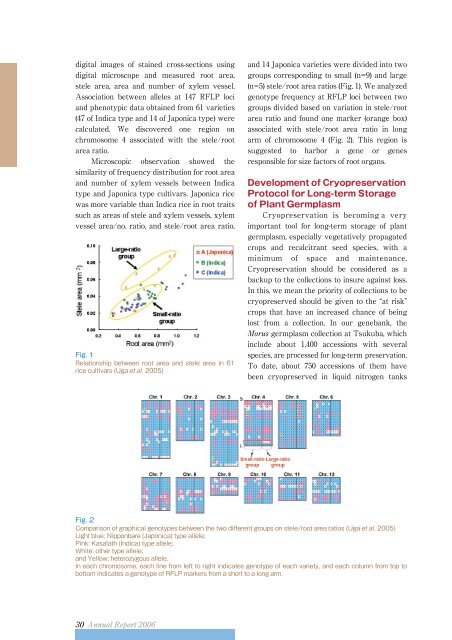Annual Report 2006
Annual Report 2006
Annual Report 2006
You also want an ePaper? Increase the reach of your titles
YUMPU automatically turns print PDFs into web optimized ePapers that Google loves.
digital images of stained cross-sections using<br />
digital microscope and measured root area,<br />
stele area, area and number of xylem vessel.<br />
Association between alleles at 147 RFLP loci<br />
and phenotypic data obtained from 61 varieties<br />
(47 of Indica type and 14 of Japonica type) were<br />
calculated. We discovered one region on<br />
chromosome 4 associated with the stele/root<br />
area ratio.<br />
Microscopic observation showed the<br />
similarity of frequency distribution for root area<br />
and number of xylem vessels between Indica<br />
type and Japonica type cultivars. Japonica rice<br />
was more variable than Indica rice in root traits<br />
such as areas of stele and xylem vessels, xylem<br />
vessel area/no. ratio, and stele/root area ratio,<br />
Fig. 1<br />
Relationship between root area and stele area in 61<br />
rice cultivars (Uga 2005)<br />
and 14 Japonica varieties were divided into two<br />
groups corresponding to small (n=9) and large<br />
(n=5) stele/root area ratios (Fig. 1). We analyzed<br />
genotype frequency at RFLP loci between two<br />
groups divided based on variation in stele/root<br />
area ratio and found one marker (orange box)<br />
associated with stele/root area ratio in long<br />
arm of chromosome 4 (Fig. 2). This region is<br />
suggested to harbor a gene or genes<br />
responsible for size factors of root organs.<br />
Development of Cryopreservation<br />
Protocol for Long-term Storage<br />
of Plant Germplasm<br />
Cryopreservation is becoming a very<br />
important tool for long-term storage of plant<br />
germplasm, especially vegetatively propagated<br />
crops and recalcitrant seed species, with a<br />
minimum of space and maintenance.<br />
Cryopreservation should be considered as a<br />
backup to the collections to insure against loss.<br />
In this, we mean the priority of collections to be<br />
cryopreserved should be given to the at risk<br />
crops that have an increased chance of being<br />
lost from a collection. In our genebank, the<br />
germplasm collection at Tsukuba, which<br />
include about 1,400 accessions with several<br />
species, are processed for long-term preservation.<br />
To date, about 750 accessions of them have<br />
been cryopreserved in liquid nitrogen tanks<br />
Fig. 2<br />
Comparison of graphical genotypes between the two different groups on stele/root area ratios (Uga 2005)<br />
Light blue: Nipponbare (Japonica) type allele;<br />
Pink: Kasalath (Indica) type allele;<br />
White: other type allele;<br />
and Yellow: heterozygous allele.<br />
In each chromosome, each line from left to right indicates genotype of each variety, and each column from top to<br />
bottom indicates a genotype of RFLP markers from a short to a long arm.













